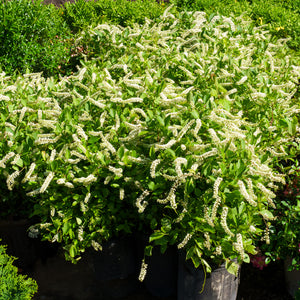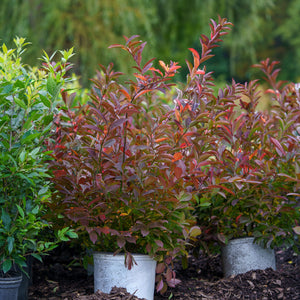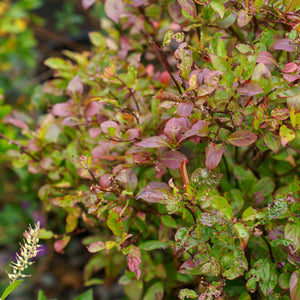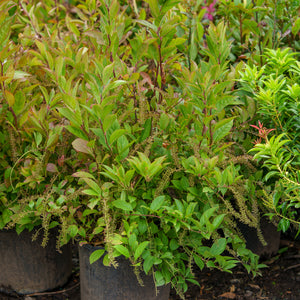The Sweetspire Guide
Sweetspire (Itea virginica) is a versatile, deciduous flowering shrub native to the southeastern United States. Known for its long, cascading white flower clusters and fiery fall color, Sweetspire is one of the few shrubs that provides multi-season interest while thriving in challenging growing conditions. It’s a favorite for woodland gardens, wet soils, pollinator landscapes, and native plantings.
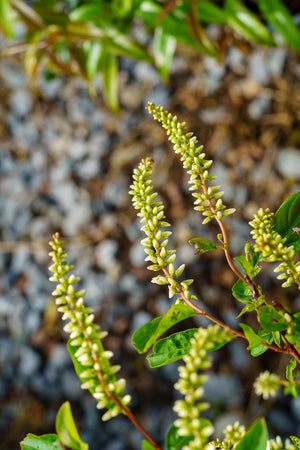
About
Itea virginica is a compact to medium-sized shrub that typically grows 3 to 5 feet tall and spreads slowly via underground runners, forming loose colonies. Its fragrant, bottlebrush-shaped flower spikes bloom in early to mid-summer, lasting several weeks and attracting pollinators such as bees and butterflies. The foliage transitions from dark green in summer to brilliant shades of red, orange, and burgundy in the fall, often holding its color well into the late season.
Popular cultivars include:
- 'Henry’s Garnet': Larger form (4–5 feet tall) with long, showy white flower spikes and exceptional fall color.
- 'Little Henry': A dwarf selection (2–3 feet tall) with dense habit and great performance in smaller spaces.
- 'Scentlandia': Compact, cold-hardy, and known for its strong floral fragrance.
- 'Fizzy Mizzy': Unique upright bloom spikes and very compact growth habit.
- 'Merlot': Rich fall color and tight branching for more formal borders or mass plantings.
Sweetspire is one of the few native flowering shrubs that thrives in full sun, deep shade, or anything in between, and it tolerates wet, clay-heavy soils where other plants often struggle.
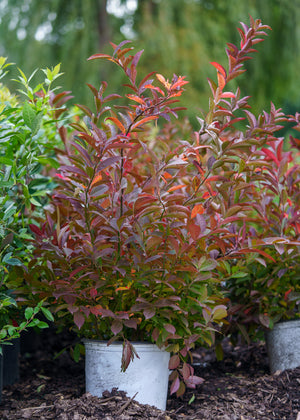
PLANTING
USDA Hardiness Zones: Zones 5–9. Some cultivars such as 'Scentlandia' have enhanced cold hardiness.
Soil: Prefers moist, slightly acidic soil rich in organic matter. Tolerates clay and wet sites well. Avoid extremely dry or compacted soils.
Sunlight: Performs well in full sun to full shade. Best flowering and fall color occur in full sun or light shade.
Watering: Likes consistent moisture, especially in the first year. Established plants tolerate occasional dryness but prefer moist soils.
Spacing: Space 3 to 5 feet apart depending on cultivar and desired density. Allow space for spreading.
Planting Time: Spring or fall is ideal. Avoid planting in peak summer heat.
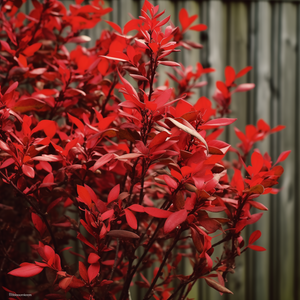
CARE
Watering: Water regularly until established. Once mature, sweetspire is tolerant of wet and dry periods but looks best with even moisture.
Fertilizing: Not heavy feeders. Apply compost or a balanced, slow-release fertilizer in early spring if needed.
Pruning: Prune right after flowering if shaping is necessary. Minimal pruning is required beyond removing dead wood or shaping gently. Flowering occurs on old wood.
Pests and Diseases: Rarely bothered by pests or diseases. Very low maintenance and resilient in most landscape settings.
Mulching: Mulch with leaf mold, bark, or pine needles to conserve moisture, suppress weeds, and maintain soil temperature.
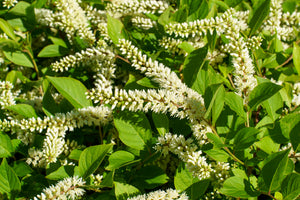
HOW TO USE
Pollinator and Native Gardens: Sweetspire supports bees, butterflies, and other beneficial insects. Combine with other native plants like Echinacea, Baptisia, or Rudbeckia for a layered pollinator garden.
Rain Gardens and Wet Sites: Its tolerance of standing water makes it a prime choice for low-lying areas, swales, and pond edges.
Woodland and Shade Gardens: Performs well under tree canopies or on woodland edges. Pair with ferns, heuchera, or hydrangeas.
Mass Plantings and Borders: Use dwarf forms like 'Little Henry' or 'Fizzy Mizzy' in drifts along walkways, patios, or property lines for a uniform look with seasonal impact.
Fall Color Displays: Combine with shrubs like Fothergilla, Ilex verticillata, or Viburnum for a colorful autumn palette.
Erosion Control: Spreading roots and tolerance for slope conditions make Sweetspire ideal for stabilizing hillsides or banks.
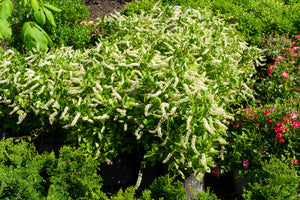
Common Questions
Is Sweetspire deer resistant? Yes, Sweetspire is generally deer resistant, though no plant is completely deer-proof.
Does Sweetspire spread? Yes, it spreads slowly by underground suckers. It can form colonies over time but is not aggressive.
How big does Sweetspire get? Standard varieties grow 3 to 5 feet tall and wide, while dwarf cultivars stay closer to 2 to 3 feet.
How to prune Sweetspire? Prune immediately after flowering by removing spent flower spikes and lightly shaping the plant. Avoid hard pruning in early spring, as it flowers on old wood.
Do rabbits eat Sweetspire? Sweetspire is not a preferred food source for rabbits and is rarely damaged.
Is Sweetspire toxic to dogs or cats? Sweetspire is not known to be toxic to pets.
Is Sweetspire evergreen? No, it is a deciduous shrub. However, its leaves may persist into late fall in some regions.
Does Sweetspire need full sun? It grows in full sun to full shade, but flowering and fall color are best in sun or part shade.
Conclusion
Sweetspire is a beautiful, adaptable native shrub that delivers summer fragrance, pollinator value, and unmatched fall color with little effort. Whether you’re designing a rain garden, adding structure to a woodland edge, or looking for a compact shrub with four-season appeal, Sweetspire offers both versatility and natural charm. With improved cultivars and strong native credentials, it’s a top choice for sustainable and eye-catching landscapes.

